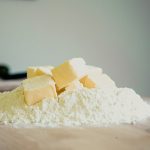Vacuum baking and partial vacuum baking are advanced techniques in the culinary and food processing industries that involve baking food under reduced atmospheric pressure. These methods offer several unique benefits, including lower baking temperatures, shorter cooking times, and the potential to alter the physical and chemical properties of food. The principles behind these techniques are closely tied to thermodynamics, particularly the Clausius-Clapeyron equation, which describes the relationship between temperature and vapour pressure. This equation helps explain why water and other liquids can boil at lower temperatures under reduced pressure, which is a critical aspect of vacuum baking.
Vacuum Baking
Vacuum baking involves placing food in an oven chamber where the air pressure is significantly lower than the atmospheric pressure at sea level (101.3 kPa or 760 mmHg). This reduced pressure environment causes water and other volatile components in the food to vaporize at lower temperatures. For example, at a partial pressure of 6.1 kPa (approximately 46 mmHg), water can boil at around 30°C (86°F) instead of 100°C (212°F) at standard atmospheric pressure. This lower boiling point has several implications:
- Gentler Cooking: Because the boiling point of water is reduced, vacuum baking allows food to cook at lower temperatures. This can be beneficial for delicate items like pastries and certain proteins, which may dry out or become tough at higher temperatures.
- Enhanced Flavor and Nutrient Retention: The lower temperatures and reduced oxidation environment in vacuum baking help preserve flavors, colors, and nutrients that might otherwise degrade or volatilize at higher temperatures. For example, delicate aromatic compounds in herbs and spices are better retained.
- Improved Texture: Foods baked under vacuum can achieve unique textures. For instance, vacuum baking can create a crispier exterior while maintaining a moist interior, as the low-pressure environment facilitates the rapid evaporation of water, leading to a flaky texture.
Partial Vacuum Baking
Partial vacuum baking is a variation where the pressure inside the baking chamber is reduced, but not as much as in full vacuum baking. The pressure is still lower than atmospheric pressure but higher than in a complete vacuum. This method offers a middle ground, providing some of the benefits of vacuum baking while maintaining a closer resemblance to traditional baking processes.
In partial vacuum baking, the partial pressure of water vapor in the oven is lowered, but not as drastically. This means that water still boils at a temperature lower than 100°C, but higher than in full vacuum conditions. This allows for a more controlled removal of moisture, which can be particularly useful in processes where a precise moisture content is desired. For example:
- Controlled Crust Formation: In partial vacuum baking, the reduced pressure can help achieve a desirable crust on baked goods, like bread, without over-drying the interior. This technique can help bakers fine-tune the balance between a crisp crust and a soft, airy crumb.
- Tailored Texture and Moisture Content: By adjusting the level of vacuum, bakers can control the final moisture content and texture of the product. This is particularly useful in producing specialty items like dehydrated fruits, crispy snacks, or unique pastry textures.
The Clausius-Clapeyron Equation and Its Role
The Clausius-Clapeyron equation is fundamental in understanding vacuum and partial vacuum baking. The equation describes how the vapor pressure of a substance changes with temperature, which is crucial for determining boiling points under different pressures. The equation is expressed as:
dP/dT=ΔHvap/TΔV
Where:
- dP/dT is the rate of change of vapor pressure with temperature.
- ΔHvap is the enthalpy of vaporization.
- T is the temperature in Kelvin.
- ΔV is the change in volume during vaporization.
For practical applications, a more useful form is:
ln(P2/P1)=−ΔHvapR(1/T2−1/T1)
Where:
- P1 and P2 are the vapor pressures at temperatures T1 and T2, respectively.
- R is the universal gas law constant.
This equation helps predict how the boiling point of water (or any other volatile component) changes under different pressure conditions. In the context of vacuum baking, it allows us to calculate the temperature at which water will boil under a given reduced pressure, thus helping to set the oven conditions for the desired cooking or baking effect.
Applications and Benefits
Applications: Vacuum and partial vacuum baking are used in various industries, from baking delicate pastries to producing freeze-dried products. These methods are particularly valuable in situations where controlling moisture content and preserving delicate flavors and nutrients are crucial.
The technology has been successfully applied to many cereal based baked foods. These include wheat and gluten-free breads and to cakes (Simsek, 2019). Flatbreads too can be delaminated
Benefits:
- Energy Efficiency: Lower baking temperatures can result in energy savings, as less heat is required.
- Extended Shelf Life: Reduced oxygen levels in vacuum environments can inhibit the growth of aerobic microorganisms, potentially extending the shelf life of products.
- Customization: Bakers and chefs can experiment with different pressure and temperature settings to achieve unique textures and flavors, offering a level of customization not possible with conventional baking methods.
Challenges and Considerations
Despite the numerous benefits, vacuum and partial vacuum baking also present challenges:
- Equipment Costs: The specialized ovens required for vacuum and partial vacuum baking are more expensive than conventional ovens.
- Process Complexity: The need to precisely control pressure and temperature can complicate the baking process, requiring more expertise and experience.
- Consistency: Achieving consistent results can be challenging due to the sensitivity of the process to small variations in pressure and temperature.
Vacuum baking and partial vacuum baking are innovative techniques that offer unique advantages in the culinary and food processing industries. By utilizing the principles of the Clausius-Clapeyron equation, these methods allow for precise control over the cooking process, enabling chefs and food technologists to enhance flavor, texture, and nutritional value. While they require specialized equipment and expertise, the benefits they offer in terms of product quality and innovation make them valuable tools in modern gastronomy. As these technologies continue to develop, they are likely to become more accessible and widely used, opening up new possibilities for creativity in the kitchen.
References
Şimşek, S. T. (2019). Vacuum-combined baking to enhance quality properties of gluten-free cake: Multi-response optimization study. LWT, 116, 108557.


Leave a Reply